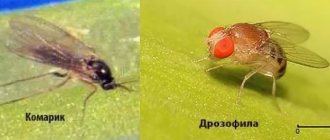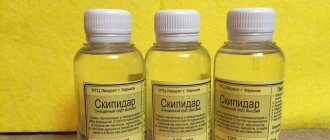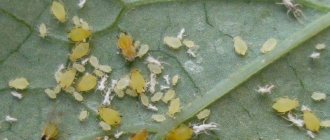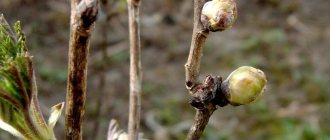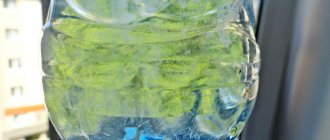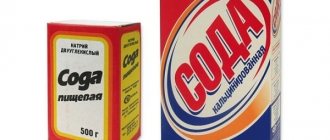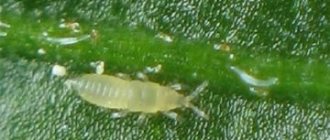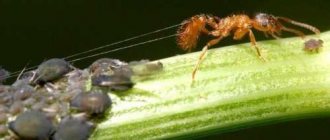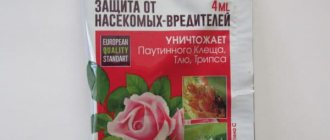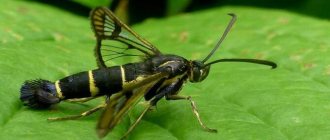Currants are one of the most popular fruit and berry crops throughout our country. Almost every gardener cultivates it.
For information on how to properly plant and grow currants on your site and about the best varieties, read the article “How to grow currants.”
This summer has been very hot, and the winter has been quite warm, so many pests have appeared in the gardens. Gardeners from different regions of the country complain that currants on their plots are suffering greatly from these uninvited guests.
Therefore, today we will talk about how to deal with currant pests, and how to determine who attacked your bushes, because many harmful insects not only damage all parts of the plant, but are also carriers of serious diseases from which the plants can die.
Pests and how to get rid of them
In addition to various viral and fungal diseases, currants can become a victim of attacks by insect pests, which can damage all parts of the plant and lead to its complete death.
Bugs
Various bugs pose a particular danger to the plant, in particular the currant borer, the larvae of which eat the core of the branches. As a result of the negative influence of the beetle, the shoots dry out, the crop yield sharply decreases, the berries become smaller and become sluggish.
Parasitic beetles appear in early summer and lay eggs on branches after 7–10 days. The larvae, which hatch after two weeks, penetrate the trunk and eat away its contents. To destroy the pest and prevent its further development, all affected parts of the bush should be destroyed.
In case of massive damage to a currant plantation, it is recommended to spray the bushes with insecticides. Treatment of foliage with Actellik, which is carried out three weeks after flowering, is highly effective.
Among the bugs, currants can also be affected by the weevil, which emerges in early spring. Individuals eat the vegetative organs of buds and flowers, and later completely destroy the leaves and buds.
The only effective way to combat weevils is to treat shrubs with chemicals. Spraying is carried out in the bud breaking phase, using pyrethroid or neonicotinoid agents.
Caterpillars
Caterpillars can cause great harm to currants: leaf roller and glass beetle. The first is a small brown butterfly with small folded wings. Leafworm caterpillars are also brown in color.
Parasites feed on the leaves of the crop, causing them to curl, turn yellow and become covered with cobwebs. The caterpillars also eat buds, flowers, and berries. Biological products and insecticides are used for the treatment and prevention of leaf rollers.
The glasswort is a small butterfly with transparent wings that lays eggs in cracks in the bark or near the buds in midsummer. The caterpillars, which hatch from the eggs after two weeks, make hollow passages in the shoots, after which the branches dry out.
Unfortunately, identifying glass is quite difficult. As a rule, it is discovered in the second year, after the branches begin to dry out sharply before the berry ripening phase. To cure currants from the parasite, it is advised to cut out and burn all affected parts. Treatment with insecticides is carried out only in the first stages of the attack, before the caterpillar has time to penetrate inside the branches.
Did you know? The most common are white, red and black currants. However, today there are varieties of the crop with different colors of berries: yellow, green, orange and even purple.
Sawflies
Berry sawflies, or rather their larvae, which develop in the ovaries and feed on seeds, cause big problems for gardeners.
Under the influence of the larvae, currant fruits ripen quite early, but are absolutely not suitable for food. Moreover, if the berries are not collected on time, the larvae come out and you have to fight with them throughout the next season.
The fight against the parasite should include the following steps:
- Before currants bloom, spray with insecticidal preparations;
- before ripening, all infected fruits must be collected and destroyed;
- in autumn, clear the area of vegetation and carefully dig up the soil;
- hill up the bushes and mulch them.
Currant fly
The currant fly or gall midge is a small mosquito-like insect that can damage all areas of the bush. In places where pest larvae develop, swellings are formed, which are called galls.
Three species of gall midges parasitize currants:
- leafy - affects the leaves of the bush;
- stem - develops on the stem;
- floral - lays eggs in flower ovaries.
Read more
How to deal with currant gall midge?
Symptoms of gall midge infestation of bushes are:
- yellowing and drying of foliage;
- formation of red spots on the leaf blades;
- leaf curling;
- inhibition of growth of young shoots;
- curling and falling of flowers.
All infected parts of the plant should be cut out and destroyed. In autumn, shrubs must be treated with Karbofos solution.
The best preventative measures against gall midges are:
- thinning of plantings;
- rejuvenation of bushes every 3 years;
- cultivation of land with tobacco water.
Preventive measures
♦ Effective boiling water. Hot water destroys the larvae of various currant pests that live and overwinter on the shoots of the bush.
At the same time, the bushes themselves do not suffer from dousing, but only become stronger. When carrying out the procedure, adhere to the following rules:
- Do not use 100% boiling water. Let the water cool a little.
- Before the event, tie the branches of the plant together.
- You can pour currants only in their dormant state.
Treatment of currants against pests is carried out during a period when it is already warmer, but there is no green haze on the bushes.
You can also water the plants in winter, when the bushes are free of leaves.
♦ Handmade. One effective method is manual collection of harmful caterpillars.
In the fall, dig up the soil and hill each bush to a height of 10-12 cm with soil to a radius of up to 70 cm.
Pupae overwintering under plant debris will end up at destructive depths - they will be destroyed by the winter cold.
The layer of soil can be removed 2 weeks after the end of flowering of the bush.
♦ Competent care. Do not cut cuttings from plants affected by currant pests; carefully handle and disinfect your working tools (especially after pruning the bushes).
Buy only high-quality seedlings from professional nurseries.
- In early spring, carry out thorough sanitary pruning of plants. To avoid the spread of parasites along with planting material, prepare cuttings before the insects become active after wintering.
Monitor the condition of your plantings! Remove old stumps, dry shoots, do not leave plant debris or leaves under the bushes (burn them in a timely manner).
Every autumn, carry out a general cleaning of the garden. Remove all weeds, dig up the soil well, and in the spring collect all the remaining grass and dry leaves.
♦ Down with the ants. The fight against aphids of all types must begin with the destruction of ant colonies.
Try to find an anthill and fill it with boiling water in the spring.
After the ants disappear, you can exterminate the aphids themselves. It hides inside the kidneys. The eyes have an enlarged, rounded shape.
All such ovaries must be collected and burned. You also need to regularly remove excess growth.
Be sure to clean the bark if it begins to peel off - there may be oviposition there.
♦ Beneficial insects. The spread of many currant pests is resisted by such beneficial entomophagous insects as aphelinus, aphidimiza gall midge, trichogramma and others.
To attract them, aromatic honey-bearing herbs (oregano, rosemary, calendula, cosmos, mallow, marigold) should be planted on the site.
Entomophages are also attracted to other plants (parsley, clover, sunflower, buckwheat, dill, celery).
- Ladybugs, hoverflies, and lacewings are good for combating many types of parasites. They will appear if there are chamomile, tansy, coltsfoot, dandelions, evergreen shrubs, and ferns in the garden.
Take your time to rid your garden of weeds. We are talking about a swan. It should be left near the currants at least 1-2 bushes.
Quinoa is an excellent treat for some types of harmful insects. The weed is capable of taking the blow, and as soon as you see that the plant is affected by currant pests, destroy it.
The most common growing problems and their causes
When cultivating black currants, gardeners may encounter a number of problems caused by unfavorable climate conditions or untimely or illiterate implementation of basic agrotechnical techniques for caring for shrubs.
Growths on branches
Growths on currant branches are considered symptoms of nectria drying caused by spores of the fungus Nectria ribis. First, small orange dots form on the shoots, which later transform into large tuberous growths.
At the stage of spore development, the tubercles become black, while the young shoots of the bush dry out and die. In the absence of high-quality and timely treatment, the shrub completely dies.
At the first signs of the disease, infected shoots should be destroyed and the cuts should be treated with garden varnish.
The best prevention of the disease is: destruction of weeds, clearing the area of remnants of vegetation and compliance with crop feeding schemes.
currant curl
Gardeners often note that currant leaves begin to dry out at the edges and curl.
Curliness may also be accompanied by the following symptoms:
- thickening of the leaf plate in some parts;
- formation of swellings in the form of bubbles on the leaves;
- reddening of leaf blades, gradual drying out and falling of leaves.
In most cases, the cause of curly hair is the Taphrine fungus or the insect aphid. To combat the latter, use a solution of Actellik or Karbofos. The fungus is destroyed using modern fungicidal drugs.
The buds open and immediately turn yellow
The cause of yellowing buds on currants may be the appearance of a bud mite, which destroys fruit buds, thereby negatively affecting the yield of the plant.
Important! The main fight against bud mites is to organize proper care of the bush and ensure proper watering.
Depending on the time of year, the signs of a kidney mite may vary:
- in winter, the buds greatly increase in size;
- in spring, the bud material swells and blooms, but quickly turns yellow;
- bud growth is uneven, plant flowering is poor;
- in autumn the buds become overly rounded and vary in size.
To combat the parasite, special preparations are used, for example, Karbofos, Phosfamide, colloidal sulfur.
There's emptiness inside the branches
The formation of voids inside the branches is evidence of the harmful effects of the pest - the glass moth. The female parasite can lay up to 60 eggs in cracks in the bark, from which caterpillars hatch and feed on the internal contents of the shoots.
Such damage leads to drying out of the branches, which occurs at the end of the flowering of the crop and at the beginning of the ripening of the fruits. To get rid of the pest, you should spray the bushes at the end of their flowering with an insecticide solution. Infected branches should be cut out and burned.
Traditional methods
| How to treat currants against pests | What to do | Who is it directed against? |
| Onion | Finely chop the onion (15-20 g), add a liter of water. Leave for 5-7 hours | Ticks |
| Dandelion officinalis | Pour the roots of the plant (20 g) with warm water (1 l). Leave for 1-2 hours | |
| Garlic | Dilute crushed garlic cloves (150-170 g) with a liter of water. Place in a dark place for 5 days. Before use, dilute 5-6 ml of concentrate with water (1 l) | |
| Laundry soap | Add soap shavings (30 g) to water (1-1.5 l) | Aphid |
| Wood ash | Ash (2 kg) is diluted with a bucket of boiling water. Leave for 2 days. | |
| Mustard | Pour mustard powder (60 g) with hot water (1-2 l). Let stand for 3 days. Concentrated liquid is diluted with 3 liters of water | |
| Tobacco | Add tobacco (300 g) to a bucket of boiling water. Leave for 2 days and add 30 g of laundry soap | |
| Needles | Leave spruce/pine needles (a glass) in hot water (2 liters) for 5-6 days. Dilute in proportion 1x10 | |
| Burdock | Pour crushed leaves of the plant (½ bucket) with water, stand for 3 days | Mole |
| Sagebrush | Boil the dried plants (1 kg) in a small amount of water for 10-15 minutes. Dilute the resulting solution with 10 liters of water. | Caterpillars and parasitic larvae |
| Tomatoes | Finely chop the tops. Add it (1 kg) to 10-12 liters of water. Boil for half an hour, then add laundry soap (40 g) | |
| Hot pepper | Finely chopped pods (100 g) pour a liter of water, boil for an hour, leave for 2 days. To use, dilute the filtered solution (10 liters of water, ½ cup of composition, add 40 g of soap) |
Plants must be sprayed with such compounds.
You should treat at a distance of 10-15 cm from the bush, this way you will more evenly distribute the healing tinctures/decoctions.
Now watch a video about how to protect currants from aphids and currant moth.
And one more video about how now, without waiting for spring, you can fight the currant bud mite.
See you soon, dear readers and good health to your garden!
Useful care tips
To prevent the development of various ailments in currants and the appearance of pests, experienced gardeners advise following a few simple rules of care when growing crops:
- regularly visually inspect the bushes for the presence of parasites or signs of disease;
- carry out regular preventive spraying of the plant with folk remedies or special store-bought preparations;
- in the fall, clear the area of vegetation, fallen leaves, and dry branches;
- all infected plants and their parts must be burned outside the site;
- strictly follow the moisture and fertilizing schemes for currants;
- carry out regular rejuvenating and sanitary pruning of shoots, preventing them from thickening;
- when growing crops on highly acidic soils, liming the soil;
- do not plant the crop in lowlands, otherwise it will suffer from fungal diseases from excess moisture;
- systematically loosen the soil.
We recommend reading how to care for blackcurrant bushes in early spring.
Protecting black currants from diseases and pests is quite simple. It is enough to follow the basic rules for caring for the plant, not to ignore the most important agrotechnical measures, and to begin the fight against diseases and parasites in a timely manner. If it is impossible to cure the bush, then it must be immediately cut out and burned outside the currant plantation.
Hello, dear readers!
If we do not take care in time to protect our currants from all kinds of diseases and pests, then all our hopes for a large harvest of this berry may not come true, even if the most productive varieties were planted and we have perfectly prepared the area for planting them.
And our favorite has plenty of enemies. These include various types of insects and mites. In total, there are more than 70 species of currant pests
Their activity sharply reduces the yield and often leads to the complete destruction of the crop.
- Saving fragrant shrubs from the attack of voracious parasites is possible only with the help of active, immediate and competent protective measures and skillful prevention.
Let's talk about the most common representatives of the malicious world, about effective control of currant pests and the most effective folk methods of treatment.
Currant terry
A specific disease of currants is caused by viruses and can completely destroy the berry plant; it is transmitted by pests: mites, aphids, bedbugs. The main signs of infection are as follows:
- The formation of a large number of shortened shoots, the so-called “panicles”.
- The leaves lose their specific currant smell and become rough, shiny, and veiny.
- Flowers and perianths turn into small narrow petals of a rich lilac color, the pistil becomes thinner and takes on a filamentous appearance.
- Berry setting stops and plant development is delayed for up to 2 weeks.
You should be careful when purchasing planting material, as the virus can penetrate the area with seedlings and cuttings.
Why do the leaves curl?
Curling of leaf blades is one of the noticeable signs of pest activity on currants. This is typical for damage by caterpillars and occurs in the later stages, when the vegetative parts begin to die off. In addition to insects, leaf deformation occurs due to a deficiency of nitrogen and potassium in the soil or due to insufficient moisture. A similar symptom occurs when infected with fungal, bacterial and viral infections. All unhealthy leaf blades must be removed as they appear. This slows down the rate of death of the bush and reduces the number of pests.
Leaves provide photosynthesis. When they twist, the natural nutritional processes of the plant are disrupted, which leads to inhibition of development and death.
Septoria
Septoria (white spot) is also most likely to occur in rainy, cool summers. Brown spots appear on the leaves, which over time become whitish with a brown border. With severe damage, the spots enlarge and merge with each other. The leaf dries up and dies. The yield of diseased bushes is reduced by 1.5–2 times.
Treatment
- Treatment with copper sulfate at intervals of 1 time every 2 weeks. The procedure must be carried out three times, the first - after the foliage has completely bloomed;
- Destruction of infected parts of the plant;
- Thinning branches to avoid excessive thickening of the bush;
- A preventive control measure is digging up the earth around the bushes, removing grass and leaves.
conclusions
- Currants can be affected by a large number of pests. The provoking factor of this process is climate change, non-compliance with agricultural technology and care.
- Glassweed, mites, aphids, scale insects and moths are the most dangerous and common pests for the gooseberry family.
- Herbivorous insects lead to inhibition of plant growth, reduced yield and death within 1-2 years.
- To combat, chemicals, biological agents and traditional methods are used.
- For prevention, it is important to properly care for currants. The garden should be regularly treated with insecticides, pruned and resistant varieties should be selected.
Botanical description
Currant is a bush from one to two and a half meters high with alternate palm-shaped three- to five-lobed leaves with large teeth along the edge. Currants bloom in raceme inflorescences, consisting of 5-10 small flowers with five petals, five stamens and five sepals. Berries up to 1 cm in diameter ripen by the end of July. The currant bush can begin to bear fruit the next year after planting. Currants are shade-tolerant, but develop better in well-lit areas.
Of the numerous plant species, the most commonly cultivated are black currant (Ribes nigrum), red currant (Ribes rubrum) and white currant (Ribes niveum); recently, yellow currant has also become popular. The main number of berries is formed on the shoots of the first, second and third years of life. Currant berries are a storehouse of organic acids, vitamins, macro- and microelements necessary for humans.
Black currant is useful for vitamin deficiency, hypertension, atherosclerosis, bronchitis, renal and hepatic colic, gastritis and other diseases. For the treatment and prevention of diseases, not only berries and products made from them are used, but also the leaves and flowers of the plant. However, currants themselves are sometimes susceptible to diseases and invasions of insect pests, and the gardener is faced with the task of promptly and correctly diagnosing currant diseases so as not to be late in treating them. As a preventive measure, proper planting and care of currants, as well as their preventive treatment, are very important.
- Protecting asters from diseases
Tuberculariosis
The fungus is caused by polyphage Tubercularia, which attacks all types of currants (black, red, golden, white). Annual growth and young shoots of shrubs are mainly affected.
The fungus penetrates the bark through damage and cracks. The pathogen is tenacious and tolerates sub-zero temperatures well.
Signs:
- red tuberous spots on the underside of leaf blades;
- the appearance of reddish bumps on the branches;
- drying of the tips of the shoots;
- necrosis of the cortex.
The disease is treated after picking berries by spraying with solutions of Khomecin, Captanol or Topsin. For prevention, Bordeaux mixture (1%) is used. It is recommended to exclude any mechanical damage to the bark, shoots, and branches of the plant.
Ognevka
This is one of the most dangerous pests of gooseberries and currants. During flowering, moth butterflies lay eggs (up to 200 eggs from one female) in the flowers of these shrubs. Then the caterpillars hatch and begin to eat berries and leaves, entwining them with cobwebs. Each caterpillar is capable of destroying 10-15 berries.
Control measures
Before and after flowering, currant and gooseberry bushes are treated with insecticide solutions (Iskra, Fufanon-Nova). For prevention, before flowering, the ground under the bush is mulched with peat or compost, and in late autumn the soil is thoroughly loosened and the bushes are hilled up.
Also, a 1% solution of Bitoxibacillin and 0.3% Lepidocide have proven themselves well in the fight against moth.
Rust
Rust is red bumps on the back of leaves that merge into orange stripes as the disease spreads. Fruits may also be affected. Excessive spring watering can provoke the disease. Rust pathogens live on conifers or on a marshy plant - sedge. If there is a wetland or coniferous plantings near the garden plot, then for growing currants it would be better to choose varieties that are resistant to rust.
Treatment
- Four times fungicidal treatment with an interval of 1.5 weeks. The first spraying is carried out before active leaf growth begins. The drug Previkur and Bordeaux mixture are highly effective;
- A popular method of combating the disease is spraying with a garlic-tobacco solution. Leave a mixture of 1 cup of garlic cloves, 200 g of tobacco dust and 2 liters of water for 3 days. Then add soap solution and a pinch of hot pepper. Treat bare branches with the resulting solution until the leaves bloom;
- Preventive measures: complete destruction of infected branches, mowing and disposal of sedge in the area adjacent to the garden, autumn harvesting of dry grass and leaves, selection of disease-resistant varieties.
Striped mosaic
If the leaf veins turn yellow and their number is constantly increasing, then this is a sign of infection with a viral disease. It is useless to fight with striped mosaic, just like with terry. The virus is spread by insects and persists in the tissues of the bush. Therefore, the only measure is to burn the bush. The soil at the site of the affected plant can be treated with a solution of potassium permanganate.
Currant aphid
Curled leaves with reddish swollen spots and twisted young shoots are signs that the plant has been attacked by aphids. Colonies of this insect can be easily found on the underside of leaves, as well as on shoots where the pest overwinters.
Control measures
To destroy aphid eggs, the bushes are watered generously with hot water (before the buds open) or treated with an insecticide (Fufanon-Nova, Aktara, Insektor, Iskra, Inta-Ts-M, Inta-Vir, Kinmiks, etc.).
- How to get rid of aphids on currants - the most effective control methods
If the leaves on the currant are covered with red spots or begin to curl, then it’s time to fight aphids.
Anthracnose
Wet weather, thickening of plantings, and the presence of weeds contribute to the development of this fungal disease. The development of anthracnose is characterized by the following symptoms:
- The pathogen mainly affects leaves, petioles and stalks.
- The first sign of the disease is the presence of small, several millimeters in diameter, brown spots.
- After some time, ulcers appear at the site of the spots, diseased leaves dry out and fall off.
The fungus that causes anthracnose overwinters in fallen leaves, so one of the effective measures to prevent the disease is the autumn collection and disposal of leaves.
Treatment
The disease can be cured using Bordeaux mixture: you need to thoroughly spray all the bushes when the first signs of infection are detected and after removing the berries. As a preventive measure, it is recommended to avoid planting a young bush in the place where the affected specimen grew, and also to burn all fallen leaves in the area.
